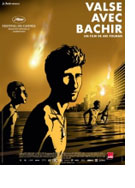

Opening 6 Nov 2008
Directed by:
Ari Folman
Writing credits:
Ari Folman
This exceptional film proves that illustrated “cartoons” can tell a story powerfully with immense impact and leave a long-lasting impression. Ari Folman, director, author and producer, has made the first animated documentary full-length film. He recreates his own experiences as a young Israeli soldier in Lebanon. In order to revive memories which have eluded him all these years, he visits his former comrades, who are scattered throughout the world. They meet in a snowbound house in Holland, in a pub, etc. Slowly, Folman remembers a failed Israeli army attack and withdrawal, the soldier who swims back along the coast to rejoin his troupe, his sadness at the burial of those who did not survive, and relaxed moments kidding around on his armoured tank. The film ends with a massacre. Although the Israeli army was not directly involved with murdering hundreds of helpless people in a refugee camp in the Sabra and Schatila districts of Beirut on September 16-18, 1982, it had taken up position all around the camp and allowed access to the local Phalangist militia. This group took revenge on the murder of their leader, Baschir Gemayel, two weeks after he was elected president of Lebanon. Ariel Sharon, then head of defense in Israel, was also considered to be responsible. Folman sees it as a holocaust with Israeli involvement.
Animation makes the scenes possibly more real than the actual event (which is blended in at the very end). In the first five minutes 26 ferocious dogs, running, barking, drooling, and climbing over each other, set the mood of aggression. They stop in front of Folman’s house and symbolize dogs he shot during the war. This event opens a small corner of his war-experience amnesia and sets him off to visit his former comrades. Their original voices are behind their animated portraits, He said that he didn’t want a “classic documentary with old men sitting in front of a grey wall, talking about their memories.” The film is told in neutral colors (in spite of his aversion to grey walls) with occasional spots of red or blue. Several times he repeats a scene of soldiers rising from the sea. The movie was actually filmed with real people, which were then copied as illustrations. All the horrors of war, real and imagined, have been filmed many times, but, perhaps because the illustrations are so personal, in spite of being just drawings, this story left an a deep impression on me in just 87 minutes. Also, the music is appropriate in every scene. After seeing hundreds of films, it isn’t very often that I still weep in the cinema as I did here. I saw it in Hebrew with German subtitles and can only hope that you find an English version. (Becky Tan)